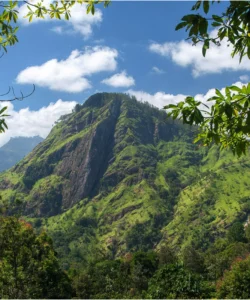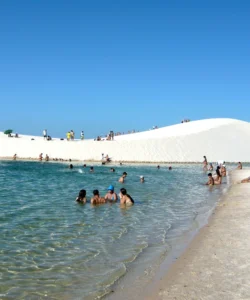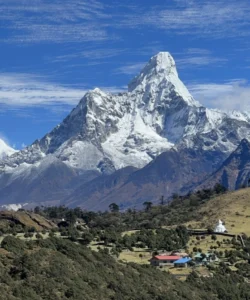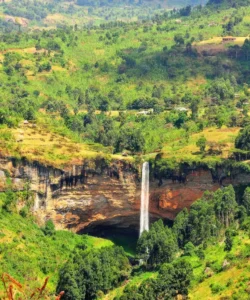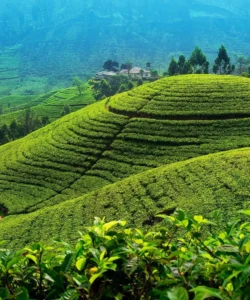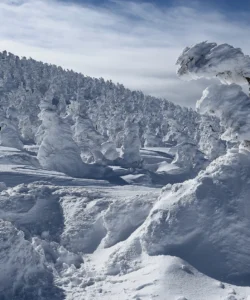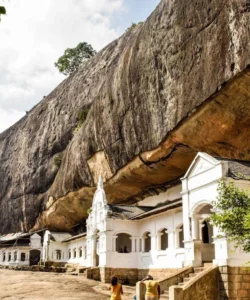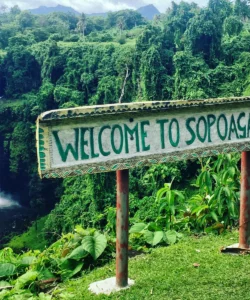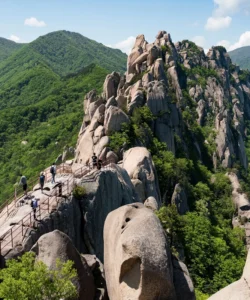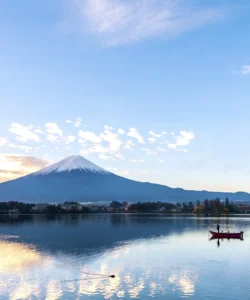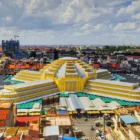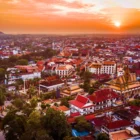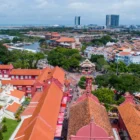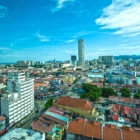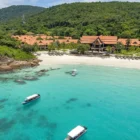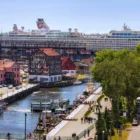Lonar Lake is an extraordinary natural wonder located in the Buldhana district of Maharashtra, India. It’s a unique saline soda lake formed by a meteorite impact, making it one of the very few hypervelocity impact craters in basaltic rock anywhere on Earth. This “cosmic scar” on the Deccan Plateau is a site of immense geological, ecological, and even astrobiological interest.
Name: Lonar Lake (also known as Lonar Crater or Lonar Sarovar)
Address: The lake is located in Lonar, a town in the Buldhana district of Maharashtra, India. It’s approximately 79 km from Buldhana city and about 170 km from Aurangabad.
How to Get There:
Access to Lonar Lake primarily involves reaching a nearby major city in Maharashtra and then taking land transport.
- By Air: The closest airport is Aurangabad Airport (IXU). It has direct flights from major Indian cities like Mumbai and Delhi. From Aurangabad, you can hire a taxi or pre-arranged transfer to Lonar (approx. 2.5 – 3 hours drive).
- By Train: Jalna Railway Station is the nearest major station, about 90 km from Lonar. Aurangabad Railway Station (AWB) is also a good option. From these stations, you’ll need to hire a taxi or use local transport to reach Lonar.
- By Road: Lonar is accessible by road from major cities in Maharashtra. You can hire a cab or take a bus. For convenience, it’s often best to hire a taxi from Aurangabad for a day trip.
- Exploring the Crater: Once you arrive in Lonar town, you can drive up to the crater rim. There are walking trails that lead down to the lakebed. Local guides are available and can offer insights into the lake’s geology, temples, and folklore.
- Best Time to Visit: The ideal time to visit Lonar Lake is during the cooler dry season, from October to March, avoiding the intense summer heat and the monsoon rains, which can make the trails slippery. The lake’s color can change depending on the season and microbial activity.
- Permit/Fees: There is typically no entry fee for the lake itself, but parking fees might apply.
Landscape and Architecture:
The “landscape” of Lonar Lake is a dramatic, circular depression in the Earth, uniquely shaped by an extraterrestrial impact. Its “architecture” is primarily natural, complemented by ancient temples around its rim and within the crater.
- Meteorite Impact Crater: The most defining feature is the nearly circular depression, approximately 1.8 kilometers (1.1 miles) in diameter and 150 meters (492 feet) deep, formed by a hypervelocity meteorite impact. This occurred in the basaltic rock of the Deccan Traps (a massive plain of volcanic basalt rock formed by ancient eruptions around 65 million years ago). It’s one of only four known hypervelocity impact craters in basaltic rock globally.
- Saline and Alkaline Lake: The crater floor is occupied by a saline and alkaline lake. The water is stratified, meaning the upper layer is often less saline and oxygen-rich, while the lower layer is significantly more saline and alkaline (pH can reach 11) and anoxic. This unique chemistry supports diverse extremophilic microorganisms.
- Changing Water Colors: The lake’s water color can mysteriously change, sometimes appearing emerald green, and at other times shifting to a stunning pink or reddish hue. This phenomenon is caused by the blooming of salt-loving microorganisms (like Haloarchaea) that flourish in the lake’s unique chemical composition.
- Ejecta Blanket and Raised Rim: The impact created a raised rim around the lake (about 20 meters high) and an “ejecta blanket” of debris extending outwards, containing fragments of impact melt and spherules, providing crucial evidence of its meteoric origin.
- Traditional Temples: The rim and slopes of the crater are dotted with several ancient and often ruined temples, some dating back to the 6th-12th centuries CE. These include:
- Daitya Sudhan Temple: Located in Lonar town, dedicated to Lord Vishnu. Built in the Hemadpanti style of architecture, it’s known for its intricate carvings and represents the victory of Lord Vishnu over the demon Lonasura (from whom the lake is believed to get its name).
- Gomukh Temple: Situated on the crater rim, famous for a perennial freshwater stream that flows from a carved “cow’s mouth” into a kund (sacred tank).
- Kamalaja Devi Temple: Dedicated to Goddess Kamalaja.
- Ram Gaya Temple: Unique for having only a single idol of Lord Ram.
Many of these temples are partially submerged during high water levels or are in various states of ruin, adding to the site’s historical mystique.
- Surrounding Forest and Biodiversity: Despite the lake’s extreme conditions, the crater’s slopes and the surrounding area are covered in forest, supporting diverse flora and fauna, including various bird species (some migratory), monkeys, deer, and even leopards.
What Makes It Famous:
- Earth’s Only Hypervelocity Impact Crater in Basaltic Rock: This is its most significant geological claim to fame. Most impact craters are found in granitic or sedimentary terrain, making Lonar’s formation in basalt unique and invaluable for scientific study.
- Saline and Alkaline Lake: The lake’s unusual dual nature (both saline and alkaline) creates a unique ecosystem, supporting extremophile microorganisms. This has drawn comparisons to conditions found on Mars, making it a site of interest for astrobiology.
- Mysterious Color Changes: The occasional and striking change in the lake’s water color, particularly the famous pink hue seen in 2020, has garnered global attention and fascination.
- Geological and Scientific Significance: Lonar Lake is a notified National Geo-heritage Monument. It has been extensively studied by scientists worldwide, including NASA, the Smithsonian Institution, and Indian research bodies, offering insights into planetary impacts and microbial evolution.
- Ancient Temples and Mythology: The presence of numerous ancient temples around the crater, intertwined with local legends (like the one about Lord Vishnu defeating the demon Lonasura), adds a rich cultural and mythological layer to this natural wonder.
- Offbeat Destination: While a UNESCO tentative site, it’s relatively less crowded than some other Indian wonders, offering a unique and tranquil experience for those seeking the unfamiliar.
Differences from Some Other Wonders:
- Meteorite Impact Origin: Unlike volcanic lakes (Lake Toba, Kelimutu), tectonic lakes, or artificial lakes, Lonar Lake’s defining characteristic is its formation by a hypervelocity meteorite impact. This extraterrestrial origin is fundamental to its uniqueness.
- Basaltic Rock Formation: Its formation in basaltic rock distinguishes it from other impact craters, which are more commonly found in granite or sedimentary rock.
- Saline and Alkaline Chemistry: While some lakes are saline (e.g., the Great Salt Lake), Lonar’s unique combination of being both saline and highly alkaline within an impact crater is exceptionally rare, supporting specialized extremophile life. This chemical uniqueness makes it a “living laboratory.”
- Color-Changing Phenomenon: While Kelimutu’s lakes also change color, Lonar’s shifts in color, particularly to pink, are directly linked to specific microbial blooms in its highly saline and alkaline water, making the mechanism and visual outcome distinct.
- Integration of Ancient Temples: Unlike purely geological sites, Lonar’s crater is surrounded by centuries-old traditional temples, adding a layer of historical and religious significance directly tied to the natural formation, a blend not found in all natural wonders.
- Wildlife Focus: While it supports biodiversity (birds, some mammals), its primary fame isn’t for specific “big game” wildlife like Komodo National Park or Jim Corbett. The focus is on its unique geological and microbiological aspects.
Lonar Lake Photos:























